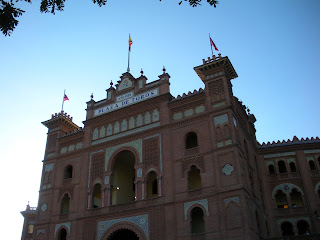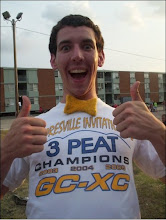Sunday July 12th: This morning I woke up and watched the running of the bulls in Pamplona on TV. The reason that I decided to watch this day and no other this week during the feast of San Fermin, is that today my classmates ran. They survived and I spotted them only after they returned and they showed me where they were. Here is the video of what I saw on the news: http://www.youtube.com/watch?v=tiP82XX7Pro&feature=popular . It is a short video (no more than 7 minutes long. After I watched the running of the bulls I ate breakfast with my host mother and then realized that I had told her 8 for breakfast and I really didn’t need it until about 8:45 or 9. So instead of trying to explain this after I had already gotten her out of bed, I left after eating, and came back to bed for about 40mins. I woke up around 9 and headed for the train station so that I could meet Abigail and Angelica for church with the Treber’s and I thought some other students. I found the stop where we were supposed to meet and I waited until about 9:45 (church is supposed to start at 10). When I realized that they weren’t going to show I decided to try and find it myself which resulted in my realizing that I had not brought directions with me. Therefore, I ran back to the apartment (figuratively) and grabbed my directions. I found the metro stop and got off and even found the road that the church was supposed to be on but it took me close to a half hour to find the church at the address listed. The address given to me was Trabaldos 2. I found trabaldos 5, 3, and 1, but couldn’t find anything lower than 4 on the other side of the road. I ended up asking four different people for directions and getting different directions each time. After finding it I figured out that both the cul-de-sac and the street were both named, and labeled “Calle De Trabaldos” (Street of Trabaldos). So I found the place and explained to Abigail and Angelica and Dr. Treber what had happened. I arrived around 10:45 (I was told worship started at 10 and the service started at 11. The whole thing started at 11 and so I wasn’t late at all. I understood very little of the sermon because he was speaking pretty quickly, but it was explained to me that it was a five point sermon on honesty and that spain as a country is a dishonest country (shopkeepers account for 10-20% loss of revenue to employee theft, according to the pastor, and this statistic is normal and shopkeepers plan for it). After church I went home and found my host mother not ready for lunch at the usual time of two so I can back down to chill for a little while and wait and ended up taking a short nap until around 2:40, at which point I went upstairs and was welcomed by a hot meal just being finished. After lunch I tried to convey the idea that I wouldn’t be at dinner because of the bullfight with the school group. I couldn’t get this across for some reason (I think it was the lack of hearing due to the whistling hearing aid). I spent the afternoon checking email and face book, trying to figure out plans for the evening. I knew that I was going to a bullfight at seven and so I took a short 30minute nap because I also knew that I wasn’t going to get a large dinner. I met Nate and Mike at the Plaza del Toros Las Ventas. We walked to the closest grocery store got some cheese bread, meat, and water for dinner. We then waited outside Las Ventas for the rest of the group to show up around 8. We found Dr. Treber, and bought our tickets from him. I am pretty sure that there wasn’t a bad seat in the house and all the tickets were 5Euros.
Here begins the description of the bullfight. I took this directly from wikipedia because the description there was far more accurate and concise than the one I just deleted.
If you are a bit squeamish just jump to the **
Spanish-style bullfighting is called corrida de toros (literally running of bulls) or fiesta brava (the ferocious festival). In traditional corrida, three toreros, or matadores, each fight two bulls, each of which is at least four years old and weighs 460–600 kg. Each matador has six assistants — two picadores ("lancers") mounted on horseback, three banderilleros ("flagmen"), and a mozo de espada ("sword page"). Collectively they comprise a cuadrilla ("entourage").
The modern corrida is highly ritualized, with three distinct stages or tercios, the start of each being announced by a trumpet sound. The participants first enter the arena in a parade to salute the presiding dignitary, accompanied by band music. Torero costumes are inspired by 18th century Andalusian clothing, and matadores are easily distinguished by their spectacular "suit of lights" (traje de luces).
Corrida in Sevilla, Spain
Next, the bull enters the ring to be tested for ferocity by the matador and banderilleros with the magenta and gold capote ("dress cape").
In the first stage, the tercio de varas ("the lancing third"), the matador first confronts the bull and observes his behavior in an initial section called suerte de capote. Next, a picador enters the arena on horseback armed with a vara ("lance"). To protect the horse from the bull's horns, the horse is surrounded by a peto — a protective matress like covering and there is some metal in there. Prior to 1930, the horse did not wear any protection, and the bull would disembowel the horse during this stage. Until this change was instituted, the number of horses killed during a fight was higher than the number of bulls killed. [10]
At this point, the picador stabs a mound of muscle on the bull's neck, weakening the neck muscles and leading to the animal's first loss of blood. The manner in which the bull charges the horse provides important clues to the matador about which side the bull favors. If the picador is successful, the bull will hold its head and horns lower during the following stages of the fight. This makes the bull's charges less dangerous while enabling the matador to perform.
In the next stage, the tercio de banderillas ("the third of flags"), the three banderilleros each attempt to plant two razor sharp barbed sticks (called banderillas) on the bull's flanks, as close as possible to the wound where the picador drew first blood. These further weaken the ridges of neck and shoulder muscle and increases the loss of blood.
In the final stage, the tercio de muerte ("the third of death"), the matador re-enters the ring alone with a small red cape (muleta) and a sword. It is a common misconception that the color red is supposed to anger the bull, despite the fact bulls are colorblind.[11][12] The cape is red to mask the bull's blood. [13] The matador uses his cape to attract the bull in a series of passes, demonstrating his control over it by bringing the bull especially close to himself. The faena (literally job) is the entire performance with the muleta, which is usually broken down into "tandas" or "series". The faena ends with a final series of passes in which the matador with a muleta attempts to maneuver the bull into a position to stab it between the shoulder blades and through the aorta or heart. The act of thrusting the sword is called an estocada.
Occasionally, if the public or the matador believe that the bull has fought bravely, they may petition the president of the plaza to grant the bull an indulto. This is when the bull’s life is spared and allowed to leave the ring alive and return to the ranch where it came from.
This a good description though it doesn’t quite capture what I experienced completely. There is a lot of strutting by the matador, and the goal is not to kill the bull quickly, but well. The matador will turn his back on the bull during the last tercio, sometimes he will stay on one knee instead of standing for the passing of the bull. Also, the matador will try to keep the bull making continuous passes before it pauses. I thoroughly enjoyed my time and was fascinated by this strange art form (it is in the arts section of the newspaper, not the sports section). Here are my pictures of the event and stadium:
I like this picture:

A Padded Horse:

The inside of the stadium:

The outside of the stadium


No comments:
Post a Comment